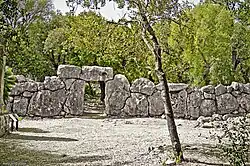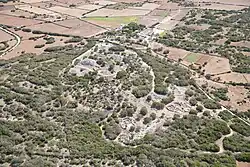Talayotic settlement

A Talayotic settlement is a type of prehistoric construction from the Iron Age found on the Spanish Balearic islands of Mallorca and Menorca. These settlements first emerged in the late second and early first millennium BCE during the Talayotic period.[1] Many settlements were built in areas that had been inhabited during the preceding Pre-Talayotic period.[2]
The sites continued to be occupied and transformed during the Post-Talaiotic period (c. 600–123 BCE), a phase characterized by the construction of new structures, such as the taula sanctuaries of Menorca.
Talayotic settlements utilised techniques of Cyclopean masonry, a method of construction using large stones without mortar.[3] The settlements typically contained one or more stone towers known as talayots, alongside other structures such as dwellings.[4][5] These sites functioned as centres for economic and social activity, based on agriculture and livestock, while the towers and walls also served as defensive outposts.[6] Fortified settlements on Menorca, including Torre d'en Galmés and Son Catlar, are among the best-preserved and architecturally developed examples documented in the Balearic Islands.[7][8]
Recent archaeological and DNA studies suggest that the Talayotic people had mixed ancestry. Their genetic profile shows links to pastoralist groups from the Eastern European steppes who had migrated to the Iberian Peninsula during the Bronze Age.[9] This mixed origin is supported by separate analyses of mitochondrial DNA, which conclude the island's settlement involved several distinct European flows with a moderate genetic affinity to Iberia.[10]
Notable surviving Talayotic settlements on Mallorca include Ses Païsses, Capocorb Vell, Son Fornés, and the seaside cemetery known as the Necropolis of Son Real.[11]
Construction of the walls

Three different construction techniques are observed in the walls of Talayotic fortified settlements:[12]
- Orthostatic walls were made of large, flat irregular slabs; known as orthostats; placed vertically on a base of horizontal stones. Above these orthostats, irregular stones of decreasing size were placed dry to increase the height of the wall.
- Walls of regular pieces were made with rows of regularly shaped stones placed directly on the foundation or the ground, without orthostats.
- Mixed walls used orthostats (similar to those mentioned above) crowned with medium-sized, rectangular stones, dry and placed in rows.
It is uncertain whether the different techniques correspond to distinct chronological periods. Only one wall has been chronologically dated; in the settlement of Ses Païsses (Artá); to around 800 BCE. It is plausible that the upper part of the wall was crowned with irregular stones and later with Punico-Roman architectural influences. Some parts of the wall may have been restored with rows of regular ashlar stones.
Archaeological surveys have identified more than 250 Talaiotic-period settlements on Mallorca, which indicates a relatively dense distribution of sites across the island.. [13]
Talaiotic settlements in Menorca
In Menorca, the settlements, in addition to the talayots, also feature structures typical of the Menorcan Post-Talaiotic period, including taula enclosures, Post-Talaiotic habitation circles, hypostyle halls, and water collection systems.[14]
Few settlements in Menorca have identifiable walls. Some display walls only in certain sections, while many show no trace of them. Houses at the periphery of settlements had thick outer walls that may have served a defensive purpose, and some habitation circles are attached to or built against wall structures.[15] Menorcan walls appear to be generally more recent than those on Mallorca, with most dating to the final centuries of the first millennium BCE, whereas the majority of Mallorcan walls date to the beginning of that millennium. However, this remains a subject of debate, as the striking similarities between the walls on both islands make it difficult to accept a significant chronological gap.
At the settlement of Son Catlar in Menorca, sections of the walls feature orthostats, while other areas exhibit more regular construction with a tendency toward horizontal rows. Additionally, rectangular defensive bastions attached to the exterior of the walls demonstrate classical influence, constructed from rectangular stones arranged in orderly rows. These reforms can be dated to the late 3rd century BCE, in the context of the Second Punic War, and subsequently, to around the 2nd century BCE, in connection with the Roman conquest of the island.[16]
Torre d'en Galmés is one of the largest documented Talaiotic settlements in the Balearic Islands, with an extensive layout that includes multiple talayots, dwellings, and communal structures.[17][18][19][20][21][22]
UNESCO World Heritage Site
Talaiotic Menorca was added to the UNESCO World Heritage List in 2023.[23] The area, divided into nine zones, encompasses several archaeological sites belonging to a prehistoric island culture characterized by a strong cultural connection with the sky.[24] The island buildings feature Cyclopean architecture over a period of approximately 1500 years, documenting a chronology spanning from the emergence of Cyclopean construction around 1600 BCE to the Roman conquest of the islands in 123 BCE.[25] Preserved monuments on the island include funerary navetas, circular houses, taula sanctuaries, and talayots.[25]
The 1,500 archaelogical sites found on Menorca, which has a land area of 700 km² (270 mi²), equates to around two sites per square kilometer.[26]
References
- ^ "Menorca, Spain: An Inconspicuous Island in the Mediterranean - Cradle of the Prehistoric Talaiotic culture". The Archaeologist. 2022-09-24. Retrieved 2025-07-31.
- ^ Anglada, Montserrat; Ferrer, Antoni; Plantalamor, Lluís; Ramis, Damià; Strydonck, Mark van; Mulder, Guy De. "Chronological Framework for the Early Talayotic Period in Menorca: The Settlement of Cornia Nou". Radiocarbon. 56 (2): 411–424. doi:10.2458/56.16962. ISSN 0033-8222.
- ^ "Talayotic Menorca". UNESCO. Retrieved 2025-07-31.
{{cite web}}: CS1 maint: url-status (link) - ^ PLANTALAMOR, Lluís. 1991. L'arquitectura prehistórica i protohistórica de Menorca i el seu marc cultural. Palma de Mallorca: Govern Balear. Conselleria de Cultura, Educació i Esports.
- ^ "Types of Structures". Menorca Talaiòtica. Retrieved 2025-07-31.
- ^ "Popular Archeology - Unearthing an Iron Age Sanctuary in the Mediterranean". Popular Archeology. Retrieved 2025-07-31.
- ^ "Talayotic Heritage". www.menorca.es. Retrieved 2025-07-31.
- ^ "Son Catlar talayotic settlement". www.menorca.es. Retrieved 2025-07-31.
- ^ "The genome of the earliest settlers of the Balearic Islands recovered". Institut de Biologia Evolutiva - CSIC UPF. Retrieved 2025-07-31.
- ^ Falchi, Alessandra; Giovannoni, Laurianne; Calo, Carla Maria; Piras, Ignazio Stefano; Moral, Pedro; Paoli, Giorgio; Vona, Giuseppe; Varesi, Laurent (2006). "Genetic history of some western Mediterranean human isolates through mtDNA HVR1 polymorphisms". Journal of Human Genetics. 51 (1): 9–14. doi:10.1007/s10038-005-0324-y. ISSN 1435-232X.
- ^ eMascaró. "Talayotic culture of Mallorca | Blog Finca Serena". www.fincaserenamallorca.com. Retrieved 2025-07-12.
- ^ "Tipus d'estructures". Menorca Talaiòtica (in Catalan). Retrieved 2025-07-07.
- ^ Pons, Gabriel (July 2018). "The Talaiotic culture of the Balearic Islands". Research Gate.
{{cite web}}: CS1 maint: url-status (link) - ^ SERRA, M.L. 1965. Arquitectura ciclópea menorquina. In Arquitectura megalítica y ciclópea catalano-balear. Coloquio sobre arquitectura megalítica y ciclópea catalano-balear, 24-26 abril 1965. Barcelona: Consejo Superior de Investigaciones Científicas: 151-172.
- ^ CARBONELL, MARTÍ «Les excavacions arqueològiques al pati davanter del Cercle 7 de Torre d'en Galmés (Menorca): estudi preliminar d'alguns materials». VI Jornades d'Arqueologia de les Illes Balears, 2014.
- ^ PRADOS, F. et al. (2017). Menorca entre fenicios y púnicos: una aproximación arqueológica desde la arquitectura defensiva. Dins Menorca entre fenicis i púnics. Universitat de Múrcia. CEPOAT. Pàgs. 105-136
- ^ "Menorca Talaiòtica".
- ^ "Prehistoria de Mallorca y Menorca".
- ^ PONS MACHADO, J. LARA ASTIZ, C. 2006. Torre d'en Galmés (Alayor, Menorca) . A Historia de las Islas Baleares. Tomo 16: patrimonio històrico y artístico. Ed. El Mundo-El Dia de Baleares. Edicions de Turisme Cultural. ISBN 84-95473-95-X. pgs. 213-215
- ^ ROSSELLÓ BORDOY, G. El poblat prehistòric de Torre d’en Gaumés (Alayor, Menorca). MIB 3. Departament de Cultura de la Generalitat de Catalunya. 1986.
- ^ SERRA BELABRE, M.Ll. El poblado talayótico de Torre d’En Gaumés. CNA X Universidad de Zaragoza. 1967.
- ^ CARBONELL, M. (2012). “El Cercle 7 de Torre d’en Galmés: Estudi d’una estructura domèstica del segle III aC a Menorca”. Treball de fi de Màster, Universitat de Barcelona
- ^ "Talayotic Menorca". whc.unesco.org. Retrieved 2025-06-03.
- ^ "El valor universal excepcional de la Menorca Talaiòtica". Menorca Talaiòtica (in Catalan). Retrieved 2025-05-24.
- ^ a b whc.unesco.org https://whc.unesco.org/en/list/1528/. Retrieved 2025-05-24.
{{cite web}}: Missing or empty|title=(help) - ^ Anglada, Montserrat; Bravo, Cristina; Riudavets, Irene. "Popular Archeology - Unearthing an Iron Age Sanctuary in the Mediterranean". Popular Archeology. Retrieved 2025-05-24.